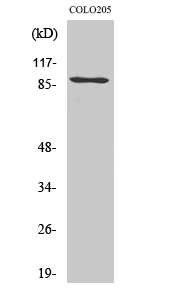
Catalog: YK0052
Size
Price
Status
Qty.
200μL
$600.00
In stock
0
100μL
$340.00
In stock
0
50μL
$190.00
In stock
0
Add to cart


Collected


Collect
Main Information
Target
PCAF
Host Species
Rabbit
Reactivity
Human, Mouse
Applications
WB, IHC
MW
93kD (Observed)
Conjugate/Modification
Acetyl
Detailed Information
Recommended Dilution Ratio
WB 1:500-2000; IHC 1:50-300
Formulation
Liquid in PBS containing 50% glycerol, 0.5% BSA and 0.02% sodium azide.
Specificity
Acetyl-PCAF (K428) Polyclonal AntibodySynthesized peptide derived from the human PCAF around the acetylation site of K428.The name of modified sites may be influenced by many factors, such as species (the modified site was not originally found in human samples) and the change of protein sequence (the previous protein sequence is incomplete, and the protein sequence may be prolonged with the development of protein sequencing technology). When naming, we will use the "numbers" in historical reference to keep the sites consistent with the reports. The antibody binds to the following modification sequence (lowercase letters are modification sites):GEkRK
Purification
The antibody was affinity-purified from rabbit antiserum by affinity-chromatography using epitope-specific immunogen.
Storage
-15°C to -25°C/1 year(Do not lower than -25°C)
Concentration
1 mg/ml
MW(Observed)
93kD
Modification
Acetyl
Clonality
Polyclonal
Isotype
IgG
Related Products
Antigen&Target Information
Immunogen:
Synthesized acetyl-peptide derived from the human PCAF around the acetylation site of K428.
show all
Specificity:
Acetyl-PCAF (K428) Polyclonal AntibodySynthesized peptide derived from the human PCAF around the acetylation site of K428.The name of modified sites may be influenced by many factors, such as species (the modified site was not originally found in human samples) and the change of protein sequence (the previous protein sequence is incomplete, and the protein sequence may be prolonged with the development of protein sequencing technology). When naming, we will use the "numbers" in historical reference to keep the sites consistent with the reports. The antibody binds to the following modification sequence (lowercase letters are modification sites):GEkRK
show all
Gene Name:
KAT2B
show all
Protein Name:
Histone acetyltransferase KAT2B
show all
Other Name:
KAT2B ;
PCAF ;
Histone acetyltransferase KAT2B ;
Histone acetyltransferase PCAF ;
Histone acetylase PCAF ;
Lysine acetyltransferase 2B ;
P300/CBP-associated factor ;
P/CAF
PCAF ;
Histone acetyltransferase KAT2B ;
Histone acetyltransferase PCAF ;
Histone acetylase PCAF ;
Lysine acetyltransferase 2B ;
P300/CBP-associated factor ;
P/CAF
show all
Background:
CBP and p300 are large nuclear proteins that bind to many sequence-specific factors involved in cell growth and/or differentiation, including c-jun and the adenoviral oncoprotein E1A. The protein encoded by this gene associates with p300/CBP. It has in vitro and in vivo binding activity with CBP and p300, and competes with E1A for binding sites in p300/CBP. It has histone acetyl transferase activity with core histones and nucleosome core particles, indicating that this protein plays a direct role in transcriptional regulation. [provided by RefSeq, Jul 2008],
show all
Function:
chromatin organization, chromatin remodeling, transcription, regulation of transcription, DNA-dependent, protein amino acid acetylation, N-terminal protein amino acid acetylation, cell cycle, cell cycle arrest, negative regulation of cell proliferation, response to endogenous stimulus, response to hormone stimulus, response to organic substance,chromatin modification, covalent chromatin modification, histone modification, histone acetylation, N-terminal peptidyl-lysine acetylation, peptidyl-lysine modification, peptidyl-lysine acetylation, cell cycle process, N-terminal protein amino acid modification, response to insulin stimulus, cellular response to insulin stimulus, cellular response to hormone stimulus, regulation of cell proliferation, response to peptide hormone stimulus, protein amino acid acylation,regulation of transcription, regulation of RNA metabolic process, chromosome organization,
show all
Cellular Localization:
Nucleus . Cytoplasm, cytoskeleton, microtubule organizing center, centrosome . Cytoplasm . Mainly localizes to the nucleus. Also localizes to centrosomes in late G1 and around the G1/S transition, coinciding with the onset of centriole formation. Subcellular location may vary depending upon cell differentiation state. Cytoplasmic at the very stages of keratinocyte differentiation, becomes nuclear at later differentiation stages. Cytoplasmic in basal epithelial cells (undifferentiated cells) and nuclear in parabasal cells (differentiated cells) (PubMed:20940255). .
show all
Tissue Expression:
Ubiquitously expressed but most abundant in heart and skeletal muscle. Also expressed in the skin, in keratinocytes (at protein level) (PubMed:20940255).
show all
Research Areas:
>>Viral life cycle - HIV-1 ;
>>Notch signaling pathway ;
>>Thyroid hormone signaling pathway ;
>>Human T-cell leukemia virus 1 infection ;
>>Viral carcinogenesis
>>Notch signaling pathway ;
>>Thyroid hormone signaling pathway ;
>>Human T-cell leukemia virus 1 infection ;
>>Viral carcinogenesis
show all
Signaling Pathway
Reference Citation({{totalcount}})
Catalog: YK0052
Size
Price
Status
Qty.
200μL
$600.00
In stock
0
100μL
$340.00
In stock
0
50μL
$190.00
In stock
0
Add to cart


Collected


Collect
Recently Viewed Products
Clear allPRODUCTS
CUSTOMIZED
ABOUT US
Toggle night Mode
{{pinfoXq.title || ''}}
Catalog: {{pinfoXq.catalog || ''}}
Filter:
All
{{item.name}}
{{pinfo.title}}
-{{pinfo.catalog}}
Main Information
Target
{{pinfo.target}}
Reactivity
{{pinfo.react}}
Applications
{{pinfo.applicat}}
Conjugate/Modification
{{pinfo.coupling}}/{{pinfo.modific}}
MW (kDa)
{{pinfo.mwcalc}}
Host Species
{{pinfo.hostspec}}
Isotype
{{pinfo.isotype}}
Product {{index}}/{{pcount}}
Prev
Next
{{pvTitle}}
Scroll wheel zooms the picture
{{pvDescr}}








.jpg)








